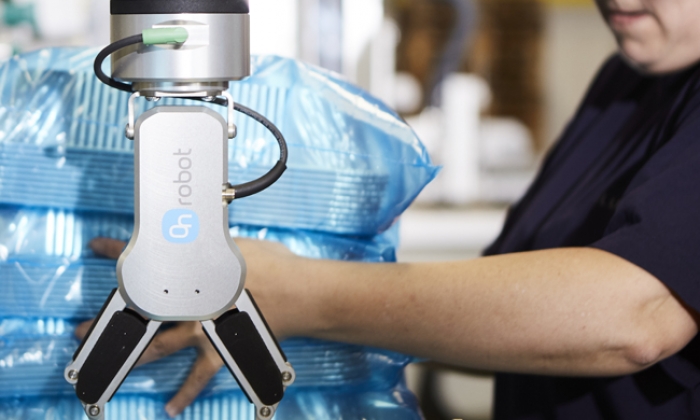Industrial vs. Collaborative Applications: End-of Arm Tooling Makes the Difference


Industrial Vs. Collaborative Robots: End-of Arm Tooling Makes the Difference
When you’re ready to automate your manufacturing processes, one of the first questions you’ll face is whether to use traditional industrial robots or collaborative robots (often called cobots). While there are many differences, it’s important to remember that robots are only part of the equation. The robot itself can’t do any work without end-of-arm tooling (EoAT) such as grippers or sensors. If you’re looking into collaborative automation, EoAT is the key to optimizing your processes and growing your business with greater flexibility, higher output, and improved quality.
Let’s look at the differences.
Industrial robots are typically large, fixed equipment designed for high-volume, extremely high-accuracy, and high-speed production. Because of the speed of the robot’s arm movement, industrial robots can present safety risks to human workers, so they usually require safety measures such as a cage to keep humans out of the robot’s work envelope. The integration of the robot and its safety caging can drive costs up substantially, as can the need for professional services to program these complex robots and integrate them with other production equipment and machines. These characteristics make traditional robots best-suited for production processes that will continue unchanged for years, where return on investment (ROI) can also take years.
For traditional industrial applications, EoAT will often be highly specific for the task. Because human workers are kept out of the work envelope, the tool doesn’t need to be designed for collaborative safety, and since the application will be programmed by an integrator, simplicity isn’t required.
Collaborative robots are ideal for manufacturers with low-volume, high-mix production or who need to safely automate processes alongside human workers. That might include automating a repetitive task and handing a part off to a human for inspection or to complete a complex assembly process. Cobots typically have lower upfront costs and are easy to program with no previous experience, so they offer fast ROI. They are small and lightweight enough that they can be easily moved and redeployed to automate different processes throughout a manufacturing facility. These versatile, cost-effective, and user-friendly tools allow businesses of almost any size (and any level of technical expertise) to increase productivity, improve quality, and respond more nimbly to changing customer demands.
The EoAT becomes a critical element of getting the most out of your collaborative robot. These tools are designed for safety around human worker and to be easy to program through the robot’s teach pendant. They’re cost-effective, highly flexible, and easy to change for different processes to support fast ROI and quick results.
If you’re leaning toward collaborative robotics, it’s important to consider EoAT to make sure you optimize your investment and gain the full advantages of your cobot.
The Impact of EoAT on Traditional vs Collaborative Applications
Traditional Applications |
Collaborative Applications |
Collaborative EoAT Requirements |
|
Big batches, little variability Ideal for large companies that manufacture high volumes of the same products for long periods |
Low-volume, high-mix Designed for low-volume, high-mix production, where the robot is often redeployed for new processes |
Easy to change Flexible, quick-change tooling to eliminate downtime between various processes |
|
Complex deployment Requires extensive programming skills and takes days or weeks to set up |
Fast and easy deployment Easy to deploy with simple programming that even inexperienced users can set up within minutes |
Easy to program Tooling that is fast and easy to program and deploy using the cobot’s built-in teach environment |
|
Requires constancy Programmed for unchanging environment and the same movement with minimal need to adapt |
Adapts to environment Flexible to adapt to changing environment and workpieces to be handled |
Adaptable Tools that easily adapt to varying sizes, shapes, and conditions of workpieces and the environment |
|
Not safe without guarding Typically requires safety guarding to keep human workers out of the robot’s work cell |
Collaborative and safe After risk assessment, humans can work alongside robot in collaborative applications |
Designed for safety Safe, collaboratively designed tools that simplify interaction with humans |
|
Focus on the robot Repeats the same actions for years, with unchanging tool that is integrated for a specific process |
Focus on the EoAT As robot arm becomes a commodity, focus shifts to EoAT to increase robot utilization |
Flexible Flexible tooling that can be used for multiple processes |
|
Big investment, longer ROI Expensive robots, system integration, and operator training requires large upfront investment and takes longer for ROI |
Lower upfront cost, faster ROI Competitive pricing, in-house integration, and ease-of-use minimize up-front costs and speed integration, uptime, and ROI |
Fast integration Cost-effective tooling that speeds integration and reduces need for additional equipment |
To learn more about how EoAT can help you automate quickly and successfully to grow your business, download our free ebook below.

|
Cách phát triển doanh nghiệp của bạn với các ứng dụng cộng tác
Với sự khởi đầu của công cụ thông minh hơn và có khả năng thích ứng cao hơn, giờ đây rô-bốt có thể hoạt động với tốc độ, sức mạnh, sự an toàn và độ chính xác cao hơn, hoàn thành một loạt các nhiệm vụ trong khi vẫn tối đa hóa ROI. Tìm hiểu thêm về cách bạn có thể cho phép sản xuất nhanh hơn với chi phí thấp hơn bằng cách tải sách điện tử miễn phí của chúng tôi về.
NHẬN SÁCH ĐIỆN TỬ MIỄN PHÍ
|

|

